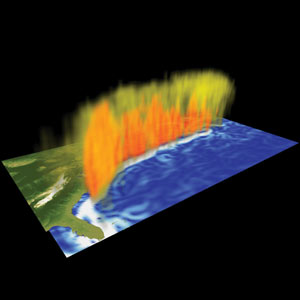|
NEWS NOTES
Gulf Streamís high heat
 F. Araki and S. Kawahara, ESC JAMSTEC |
| The Gulf Stream doesn’t just flow north along the eastern United States — its energy also rises as much as 11 kilometers into the troposphere, as shown in this 3-dimensional image (with red indicating the fastest rise). |
Although known to warm North Atlantic waters near the Carolinas and spawn strong storms, the Gulf Stream’s overall impact on climate has been a source of debate. Thought since the mid-19th century to protect Western Europe from freezing in the winter, scientists have more recently reduced the Gulf Stream’s central role in moderating that climate to just one of several factors warming up the North Atlantic. But new research has identified an atmospheric connection between the warm waters of the Gulf Stream and the upper reaches of the troposphere. And that, researchers say, could expand the Gulf Stream’s impact on climate once again, perhaps extending it even farther around the world.
The fast-moving current of warm ocean water called the Gulf Stream flows northward along the southeastern coast of the United States and then eastward across the North Atlantic Ocean, and has long been a subject of interest to oceanographers and climate scientists alike. For one thing, the current “transports a lot of heat northward,” says Shang-Ping Xie, a meteorologist at the University of Hawaii in Honolulu. As a result, scientists have been curious to know both how much heat the Gulf Stream brings to the western shores of Europe, and how susceptible the strength of the current is to changes in climate.
Overall, the Gulf Stream’s impact on climate has been thought to be regional rather than global, Xie says. That’s partially because the current is actually very narrow: In satellite images of the Atlantic Ocean, it appears as just “a streak of warm water,” he says. Still, recent higher-resolution satellite images have observed large bands of rain that closely hug the current — “a very strong piece of evidence that it’s anchoring a major rain band,” Xie says, which would suggest the Gulf Stream has at least a powerful impact on regional weather.
Another factor in how far-reaching the current’s influence may be is whether that influence extends more than one to two kilometers above sea level and into the upper troposphere. At sea level, air temperatures are quickly warmed by the warmer ocean waters, but friction and rapid exchange of heat between the air and the ocean also quickly disperse that heat. “As soon as it leaves the Gulf Stream, the [air] will cool down rapidly,” Xie says.
If the Gulf Stream’s energy reaches high into the atmosphere, however, its impact wouldn’t be dispersed so easily. Instead, that energy could impact the jet streams — very high air currents thousands of kilometers long that stretch far around the planet — and could significantly impact the climates of both Europe and North America. “The troposphere is the part of the atmosphere where weather patterns are determined,” says Dudley Chelton, an oceanographer at Oregon State University in Corvallis, who was not involved in the new study. Some of the world’s highest mountains — the Himalayas and the Alps — stand in the path of the jet stream and can change wind directions and thus alter weather patterns far away, Chelton says. “The same thing could happen from this [Gulf Stream] effect.”
But some satellites looking down from above can only see a two-dimensional picture of the Gulf Stream’s impact as it plays out across the surface of Earth — they can’t see how high into the atmosphere that impact goes. So Xie and his co-workers turned to brand-new model analyses of weather data, made by the European Centre for Medium-Range Weather Forecasts in the United Kingdom, to study wind patterns above the current. From those data, the team found patterns of winds sweeping upward and clouds forming above the current — not just at the surface, but up to 11 kilometers high in the atmosphere, all meandering along with the Gulf Stream, they reported March 13 in Nature.
“It’s like there’s a direct window that allows [the Gulf Stream’s energy] to propagate all the way to the troposphere,” Xie says. “That can carry its influence very far away.”
Whether features that have sharp changes in sea-surface temperatures relative to the surrounding waters — such as the narrow warm band of the Gulf Stream in the colder Atlantic Ocean — strongly affect atmospheric circulation has been argued about “for decades,” says John M. Wallace, a climatologist at the University of Washington in Seattle.
And in fact, Chelton says, previous studies have observed similar connections between sea-surface temperatures and the troposphere, although they focused on much shorter time scales — such as during a specific storm — rather than on the current’s long-term impact on climate. “This is really a fundamental result,” he says. “It shows so clearly that the signal affects the entire troposphere all the way up to the top.” Still, he adds, although the evidence for the link is convincing, scientists are still working to understand exactly what is driving that link. “This is an area of very active research.”
In the meantime, the current study “certainly strengthens the case for being really careful about sea-surface temperature in weather prediction,” Wallace says. “It’s of great interest to the forecasting community.”

 Subscribe
Subscribe


